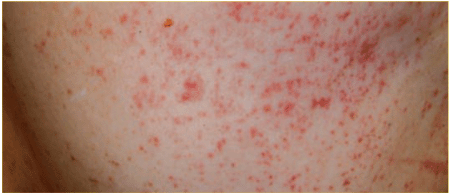



Papular Dermatitis
Papular dermatitis (PD), sometimes seen at the abattoir and on farms, is a type of skin lesion most often the result of hypersensitivity to sarcoptic mange mites. The impacts of mange as well as its prevention and treatment are outlined in No. 12 in the 'Action for Productivity' series from BPEX.A number of agents and diseases can cause papular dermatitis, consequently PD does not confirm the presence of a specific condition. High levels of PD lesions in slaughter pigs are highly suggestive of the presence of mange but in some cases, further investigation may be required.
PD appears as small, raised red spots on the skin. In the case of mange, these spots are most frequently seen around the neck behind the ears, along the flanks and over the hams. The ears are a favoured site of infestation for sarcoptic mange mites and in live pigs with chronic infestations, crusting lesions may be seen within the ears.
Sarcoptic mange
- A parasitic disease of pigs caused by the host-specific mite Sarcoptes scabiei var. suis
- Can persist in the environment for up to three weeks if conditions are ideal, contaminated transport can therefore spread the disease
- Spread from pig to pig by direct contact or possibly by vectors
- The mite burrows into the skin and lays eggs in tunnels within the skin
- Affected pigs are often seen rubbing against any available surface and ear-shaking
- Most commonly seen in pigs of eight to 12 weeks of age.
Other external parasites
- Includes flies, mosquitoes, lice and other mites
- Can cause considerable skin irritation, sometimes resulting in loss of blood
- Lice may be visible on the surface of the skin
- If mange treatment is carried out, lice are relatively uncommon because the mange treatment will kill them.
Impact of Papular Dermatitis Sarcoptic Mange
This is one of the few skin conditions to have any known economic significance.The loss of productivity and welfare implications can:
- Increase piglet mortality due to overlying by affected sows and gilts
- Reduce growth rates by up to 20 per cent
- Worsen feed conversion efficiency by up to 12 per cent
- Lead to a reduced market value and carcase downgrading; in severe cases affected skin can account for up to 8 kg of a 100 kg pig and be condemned due to lesions
- Cause apparent infertility since chronically infected boars may fail to work due to discomfort
- Increase maintenance costs due to the damage caused by pigs rubbing against fixtures
- May predispose affected pigs to other skin diseases eg greasy pig disease
Table 1. Effect of mange infestation on pig performance from 50-80kg

External Parasites
- No direct impact on the performance of the pig has been measured
- Are involved in the transmission of other diseases, e.g. flies can mechanically transmit bacteria and viruses from one pig to another, directly in the case of biting flies or indirectly by contaminating feed
- Can also transmit infections from one pig farm to another if they are less than 3km (2 miles) apart
- Are a nuisance to the pigs and stock people leading, for example, to aggressive sows at farrowing
Management Guidelines: Mange
If a herd is free from mange, it is one of the easiest diseases to keep out because it can only be introduced by carrier pigs. However, once introduced, it can become endemic.
To keep mange out:
- Be vigilant when sourcing replacements and examine incoming pigs carefully during their period of isolation
- Treat all incoming stock with avermectin two weeks prior to integration, following veterinary advice
- Operate good biosecurity: Isolate all incoming stock in suitable facilities (ideally situated on the perimeter of the unit), operate on an all-in all-out basis and clean and disinfect between batches
Where mange is endemic in a herd, a vigorous and persistent programme of control is needed; this should be split into breeding and feeding herds. Discuss with your vet.
Breeding herd
- Treat all animals simultaneously where possible, either by injection or by medicating feed; repeat every six to 12 months
- Do not forget to treat boars; they are in direct skin contact with breeding females and can be chronic carriers.
Feeding herd
- Young pigs will pick up the mite either from the sow, from contact with older infested pigs or from a contaminated environment
- Provided the disease is controlled in the breeding herd and that all-in all-out pig flow into clean accommodation is practised, there is often no need to treat growing pigs
- In units with continuous flow finishing, this is likely to be the place where problems may be seen
- Where these criteria are not followed, in-feed treatment soon after weaning is effective, usually given in the second diet one week after weaning for seven days
- Pay particular attention to hospital areas as, although they should be regularly de-populated and cleaned, they rarely are. Where mange is present, treat pigs going into and coming out of pens as routine (unless going direct to slaughter)
- Prolonged meat withdrawal periods for most of the effective medication forms make a whole herd eradication program on a breeder/feeder farm difficult without partial depopulation
- A range of protocols have been developed to eradicate mange, involving a combination of medication and hygiene measures. Consult your vet to discuss the options.
BPHS Reports
The BPHS report provides an average PD score for every batch of pigs on a scale of 0-3.The report also shows the percentage of pigs affected.A variation in score may be seen depending on the time of the year, environmental conditions, type of housing and, if definitely due to mange, on the treatment programme in place.

May 2013








